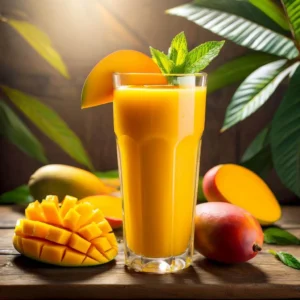Introduction
Mango juice is a delicious and refreshing tropical drink enjoyed worldwide for its sweet and tangy taste. Packed with essential nutrients and bursting with flavor, this golden-hued beverage is not just a summer favorite but also a powerhouse of health benefits. Whether you enjoy it fresh, blended into smoothies, or as part of an exotic drink, mango juice is a must-try for any fruit lover.
In this guide, we will explore everything about mango juice, including its nutritional benefits, cultural significance, easy-to-follow recipes, and much more!
The Origins of Mango – The King of Fruits
Originating from South Asia, the mango is often called the “King of Fruits” due to its rich history, distinct flavor, and numerous health benefits. The fruit is known for its versatility—it can be consumed fresh, blended into smoothies, incorporated into savory dishes, or enjoyed as juice. Mango juice, however, stands out as one of the most popular ways to consume this fruit, offering a delightful combination of natural sweetness and a refreshing burst of flavor.
A Nutrient-Packed Powerhouse
The appeal of this tropical drink goes beyond its tantalizing taste. The fruit itself, with its rich orange flesh, is a powerhouse of nutrients. Mangoes are packed with essential vitamins, including Vitamin C, which boosts immunity, and Vitamin A, which supports eye health. Additionally, they are a good source of dietary fiber, antioxidants, and minerals like potassium and magnesium. When blended, mangoes retain much of their nutritional value, making this beverage not only delicious but also highly nutritious. It can be a great addition to a balanced diet, providing a natural energy boost while keeping you hydrated.
The Unique Texture and Flavor
What sets this golden fruit nectar apart from other fruit-based drinks is its smooth, thick consistency, thanks to the fiber found in mango flesh. Unlike some beverages that feel thin and watery, this one has a rich texture that leaves a satisfying mouthfeel. This velvety nature makes it an excellent base for smoothies or a great mix with other tropical flavors like pineapple, coconut, or passion fruit. The endless combinations offer a delightful sensory experience for those who love experimenting with new tastes.
The Simplicity of Preparation
One of the greatest advantages of this refreshing beverage is how easy it is to prepare. Whether using a blender, a juicer, or even hand-pulping the fruit, the process is simple and accessible. Adding water or coconut water helps achieve the perfect consistency, while sugar or honey can be adjusted based on the sweetness of the mangoes. For a tangy twist, a squeeze of lime or lemon enhances the refreshing zest. Making this drink at home ensures complete control over ingredients, allowing for a fully customized experience.
Cultural Significance Around the World
This vibrant tropical beverage holds deep cultural significance, especially in regions where mangoes are abundantly grown. In countries like India, the Philippines, Thailand, and Mexico, the fruit is celebrated as a symbol of fertility and prosperity. It is often enjoyed as part of daily life, whether during meals or as a cooling refreshment in the summer heat. During peak season, fresh fruit-based drinks are commonly sold by street vendors, offering locals and visitors a taste of tradition.
Modern Culinary Uses
Beyond its cultural roots, this exotic drink has also become a staple in modern gastronomy. Its bright color and tropical essence make it a popular ingredient in mocktails and other specialty beverages. Additionally, it serves as a fantastic base for salad dressings, marinades, and desserts like sorbets, puddings, and jellies. The versatility of this fruit-infused drink allows it to complement a wide range of culinary creations.
A Timeless Favorite Worldwide
The demand for this luscious beverage has only grown over time, with many brands offering it in bottles and cartons for easy accessibility. However, nothing compares to the taste of fresh, homemade versions made from ripe, high-quality fruit. This connection to the source enhances the experience, making it an indulgence enjoyed at home, on vacation, or at social gatherings. No matter the occasion, this golden delight continues to bring a sense of refreshment and enjoyment.
How to Make Fresh Mango Juice at Home
Ingredients & Preparation
| Ingredient | Quantity | Optional |
|---|---|---|
| Ripe mangoes | 2 large | No |
| Water or coconut water | 1 cup | Yes |
| Sugar or honey | 1-2 tbsp | Yes |
| Ice cubes | As needed | Yes |
| Lime or lemon juice | 1 tbsp | Yes |
Step-by-Step Instructions
- Prepare the Mangoes: Peel the mangoes and cut them into small, bite-sized pieces.
- Blend: Add the mango pieces to a blender with water (or coconut water) and sugar or honey if desired. Blend until smooth.
- Taste and Adjust: Taste the juice and adjust the sweetness or add more water if it’s too thick.
- Serve: Serve in glasses over ice cubes, if preferred, and finish with a splash of lime for a refreshing touch.
- Optional: Garnish with a slice of mango or a mint leaf for an extra touch.
Nutritional Value of Mango Juice
| Nutrient | Per 100ml |
| Calories | 60 kcal |
| Carbohydrates | 15g |
| Sugars | 13g |
| Fiber | 1.6g |
| Vitamin C | 36% DV |
| Vitamin A | 21% DV |
| Potassium | 168mg |
DV = Daily Value
Mango Juice in Different Cultures
1. India – Aam Ras
- Served with pooris (fried bread).
- Commonly enjoyed during summer festivals.
2. The Philippines – Mango Shake
- Blended with milk or condensed milk.
- Often topped with whipped cream.
3. Mexico – Mango Agua Fresca
- Mixed with lime juice and a pinch of chili powder.
- A popular street beverage.
Best Ways to Enjoy Mango Juice
1. Mango Juice Smoothie
- Blend with banana, yogurt, and chia seeds for a creamy drink.
2. Mango Mocktail
- Mix with sparkling water and mint for a fizzy, refreshing beverage.
3. Mango Lassi
- Blend with yogurt, cardamom, and honey for a traditional Indian drink.
FAQ: Everything You Need to Know About Mango Juice
1. Is mango juice good for weight loss?
Yes, when consumed in moderation, mango juice can be part of a healthy diet. Opt for homemade juice without added sugar to keep calories in check.
2. Can diabetics drink mango juice?
Diabetics should limit consumption as mango juice contains natural sugars. Opt for small portions and consult a healthcare provider.
3. How long does fresh mango juice last?
Fresh mango juice should be consumed within 24 hours when refrigerated. Keep it in a sealed container to preserve its freshness.
4. Can I freeze mango juice?
Yes! Store mango juice in ice cube trays for easy use in smoothies or drinks.
5. Which mangoes are best for making juice?
The best mangoes for juice include Alphonso, Haden, Tommy Atkins, and Kent, known for their rich sweetness and smooth texture.
Conclusion
Mango juice is more than just a delicious drink; it’s a nutritious, hydrating, and versatile beverage enjoyed worldwide. Whether you sip it fresh, mix it into a smoothie, or create an exotic mocktail, mango juice brings refreshment and health benefits to every glass.

Mango Juice: Refreshing, Nutritious & Easy to Make
Equipment
- Blender
- Knife
- Cutting board
- Glasses
Ingredients
- 2 ripe mangoes
- 1 cup water (or coconut water)
- 1-2 tbsp honey or sugar (optional)
- Ice cubes (optional)
- 1 tbsp lime or lemon juice
Instructions
- Preparation Steps:Peel and cut the mangoes into small chunks.Add mango pieces to a blender with water or coconut water.Blend until smooth.Taste and adjust sweetness if needed.Serve chilled over ice cubes, with a squeeze of lime for extra zest.

